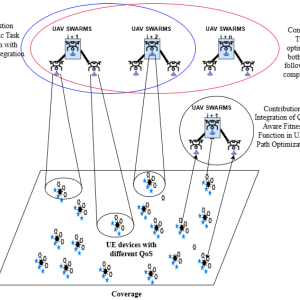As the successor to 5G, 6G is expected to deliver unprecedented speeds, ultra-low latency, and the capacity to support an extensive range of applications, from autonomous vehicles to the Internet of Things (IoT) and beyond. Central to this technological leap is the Future of 6G Satellite Networks systems capable of meeting the stringent demands of 6G networks, particularly in the context of satellite communications. This article delves into the innovative antenna designs that are paving the way for the next generation of satellite networks, exploring their implications, challenges, and the future they herald.

The Imperative for Advanced Antenna Systems in 6G
The transition from 5G to 6G is not merely an incremental upgrade; it represents a quantum leap in communication capabilities. 6G networks are anticipated to operate in the terahertz (THz) frequency range, enabling data transfer rates of up to 1 terabit per second (Tbps). This requires a significant overhaul of existing infrastructure, particularly in the domain of satellite communications, where antennas play a crucial role.
Antennas are the linchpins of any wireless communication system. They serve as the interface between the transmitting and receiving devices, converting electrical signals into electromagnetic waves and vice versa. In the context of 6G, the requirements for antennas are far more stringent than in previous generations. These antennas must be capable of handling higher frequencies, providing broader coverage, and supporting a vast number of devices simultaneously. Moreover, they must be highly directional to minimize interference and ensure efficient use of the spectrum.
Challenges in Designing 6G Antennas
Designing antennas for 6G satellite networks presents a unique set of challenges. The higher frequencies associated with 6G (in the range of 100 GHz to 1 THz) offer the potential for faster data transmission, but they also come with several drawbacks. Terahertz waves are more susceptible to atmospheric absorption and scattering, which can significantly reduce their range and reliability. This necessitates the development of highly efficient antennas that can overcome these limitations.
Beamforming and Massive MIMO (Multiple Input Multiple Output) are two key technologies that are expected to play a pivotal role in 6G antenna systems. Beamforming involves the use of multiple antennas to direct the signal in a specific direction, thereby increasing the signal strength and reducing interference. This is particularly important in satellite communications, where the distance between the transmitter and receiver can be vast. Massive MIMO, on the other hand, involves the use of a large number of antennas at both the transmitter and receiver ends, allowing for the simultaneous transmission of multiple data streams. This not only increases the capacity of the network but also enhances its resilience to interference.
The Role of Reconfigurable Intelligent Surfaces (RIS)
One of the most promising innovations in the field of 6G antenna design is the concept of Reconfigurable Intelligent Surfaces (RIS). RIS are artificial surfaces embedded with a large number of small, passive elements that can manipulate electromagnetic waves. These surfaces can be dynamically reconfigured to direct and focus signals in real-time, effectively acting as smart mirrors that enhance the coverage and capacity of the network.
RIS technology is particularly well-suited for satellite communications, where it can be used to overcome the limitations of traditional antennas. By deploying RIS on satellites or ground stations, it is possible to create highly focused beams that can reach even the most remote and underserved areas. This not only improves the efficiency of the network but also reduces the power consumption of the satellites, extending their operational lifespan.
Innovations in Antenna Materials and Structures
The development of advanced antenna systems for 6G also necessitates the exploration of new materials and structural designs. Traditional antenna materials, such as copper and aluminum, may not be suitable for the high-frequency requirements of 6G. Instead, researchers are investigating the use of metamaterials and graphene-based antennas, which offer superior performance at terahertz frequencies.
Metamaterials are artificial materials engineered to have properties that are not found in nature. By manipulating the structure of these materials at the microscopic level, it is possible to create antennas with enhanced capabilities, such as higher gain, reduced size, and improved efficiency. Graphene, a two-dimensional material composed of a single layer of carbon atoms, is another promising candidate for 6G antennas. Its unique electrical properties make it ideal for use in ultra-high-frequency applications, where it can enable the creation of compact, lightweight, and highly efficient antennas.
Satellite Constellations and the Need for Agile Antennas
The deployment of 6G networks will likely involve the use of large-scale satellite constellations, consisting of hundreds or even thousands of small satellites orbiting the Earth. These constellations will require antennas that are not only powerful but also highly agile. Agility in this context refers to the ability of the antenna to quickly and accurately adjust its beam direction in response to the movement of the satellites and the changing position of the target devices.
To achieve this level of agility, researchers are exploring the use of phased array antennas and electronic beam steering technologies. Phased array antennas consist of multiple individual antenna elements that can be electronically controlled to steer the beam in different directions. This allows for rapid and precise adjustments, which are crucial for maintaining a stable connection in a dynamic satellite network. Electronic beam steering, on the other hand, eliminates the need for mechanical movement, further enhancing the speed and reliability of the antenna system.
Integrating AI and Machine Learning into Antenna Design
The complexity of 6G networks necessitates the use of advanced algorithms to manage and optimize the performance of the antennas. Artificial Intelligence (AI) and Machine Learning (ML) are expected to play a critical role in this regard. By analyzing vast amounts of data in real time, AI and ML can be used to dynamically adjust the antenna parameters, such as beam direction, power level, and frequency allocation, to maximize the efficiency of the network.
AI-driven antenna design is also expected to accelerate the development process by enabling the simulation and optimization of different designs before they are physically constructed. This can significantly reduce the time and cost associated with the development of new antenna systems, allowing for more rapid innovation and deployment.
Potential Applications of 6G Satellite Networks
The impact of 6G satellite networks will extend far beyond traditional telecommunications. The high-speed, low-latency, and global coverage offered by these networks will open up new possibilities in a wide range of industries.
Autonomous Vehicles: One of the most promising applications of 6G satellite networks is in the field of autonomous vehicles. The ability to transmit large amounts of data with minimal delay is critical for the safe and efficient operation of self-driving cars, drones, and other autonomous systems. 6G satellite networks will provide the necessary infrastructure to support these applications on a global scale, enabling real-time communication and coordination between vehicles, infrastructure, and cloud-based systems.
Remote Healthcare: Telemedicine and remote healthcare have become increasingly important in recent years, particularly in the wake of the COVID-19 pandemic. 6G satellite networks will enable the delivery of high-quality healthcare services to even the most remote and underserved areas, providing a lifeline for communities that lack access to traditional healthcare facilities. The high-speed, low-latency communication provided by 6G will also enable the use of advanced technologies such as remote surgery, where a surgeon can operate on a patient from a different location using robotic systems.
Industrial Automation: The Industrial Internet of Things (IIoT) is another area that stands to benefit from the deployment of 6G satellite networks. The ability to connect a vast number of devices and sensors across large geographical areas will enable the automation and optimization of industrial processes, leading to increased efficiency, reduced costs, and improved safety. 6G networks will provide the necessary bandwidth and reliability to support the real-time data exchange required for these applications, paving the way for the next generation of smart factories and automated systems.
Environmental Monitoring and Climate Research: The global coverage and high-resolution data provided by 6G satellite networks will also be invaluable for environmental monitoring and climate research. These networks will enable the continuous monitoring of environmental parameters such as temperature, humidity, and air quality, providing real-time data that can be used to track and respond to climate change. This will be particularly important for remote and hard-to-reach areas, where traditional monitoring systems are not feasible.
National Security and Defense: In the realm of national security and defense, 6G satellite networks will provide the backbone for a new generation of secure communication systems. The high-speed, low-latency communication offered by these networks will be essential for the operation of advanced military systems, including unmanned aerial vehicles (UAVs), satellite-based surveillance, and secure battlefield communication networks. The ability to transmit large amounts of data in real-time will also enhance the effectiveness of intelligence gathering and analysis, enabling faster and more informed decision-making.
The Future of 6G Antenna Technology
The development of advanced antenna systems for 6G satellite networks is still in its early stages, but the potential impact of this technology is already becoming clear. As researchers continue to explore new materials, designs, and technologies, the capabilities of 6G antennas will only continue to improve. This will pave the way for the deployment of 6G networks that are faster, more reliable, and more capable than ever before.
Looking ahead, the integration of 6G technology into satellite networks will likely lead to a new era of global connectivity. The ability to provide high-speed, low-latency communication to every corner of the globe will have a profound impact on society,
enabling new applications and services that were previously unimaginable. From autonomous vehicles to remote healthcare, the possibilities are endless, and the future is bright.
Conclusion
The journey towards the deployment of 6G satellite networks is a complex and challenging one, but it is also full of promise. The development of advanced antenna systems will be a critical factor in the success of these networks, enabling them to deliver the high-speed, low-latency communication that is essential for the next generation of applications. As researchers and engineers continue to push the boundaries of what is possible, the future of global connectivity looks more exciting than ever.










